Effect of Depositional Environment and Climate on Organic Matter Enrichment in Sediments of the Upper Miocene—Pliocene Kampungbaru Formation, Lower Kutai Basin, Indonesia
Abstract
:1. Introduction
2. Geological Setting

3. Materials and Methods
3.1. Field Data
3.2. Leco Elemental Analysis
3.3. Organic Petrography
3.4. X-ray Diffraction (XRD)
4. Results
4.1. Lithofacies Characteristics
4.2. Facies Associations
4.2.1. Fluvial-Dominated Distributary Channel Facies Association (CH)
4.2.2. Sheet-like Sandstone (UC)
4.2.3. Tide-Influenced Distributary Channel (DC)
4.2.4. Mouth Bar (MB)
4.2.5. Crevasse Splay
4.2.6. Delta Plain
4.2.7. Delta Front
4.3. Leco Elemental Analysis
4.4. Organic Petrography
4.5. Mineralogical Characterization
4.5.1. Bulk Mineralogy
4.5.2. Clay Mineralogy (<2 μm Fraction)
5. Discussion
5.1. Organic Matter and Mineral Characteristics
5.2. Paleoclimate Condition
5.3. Depositional Environments
6. Conclusions
- Eleven lithofacies were identified and further grouped into seven facies associations as follows: the fluvial-dominated distributary channel (CH), sheet-like sandstone (UC), tide-influenced distributary channel (DC), crevasse splay (CS), mouth bar (MB), delta plain (DP) and delta front (DF). Sediments of the Kampungbaru Formation reflect deposition in a deltaic environment by predominant fluvial and subordinate tidal processes.
- The paleoclimate during deposition of the Upper Miocene and Pliocene Kampungbaru Formation was generally warm and humid, as evidenced by the dominance of the vitrinite maceral group. High proportions of vitrinite in the coals indicate that the original plant material consisted essentially of woody plant tissue, and peatification occurred under relatively wet-reducing conditions.
- Clay mineral analysis revealed the predominance of kaolinite and mixed-layer I/S supporting further warm and humid climate conditions during the deposition of the formation.
Author Contributions
Funding
Data Availability Statement
Acknowledgments
Conflicts of Interest
References
- Demaison, G.J.; Moore, G.T. Anoxic environments and oil source bed genesis. Org. Geochem. 1980, 2, 9–31. [Google Scholar] [CrossRef]
- Sia, S.G.; Abdullah, W.H. Geochemical and petrographical characteristics of low-rank Balingian coal from Sarawak, Malaysia: Its implications on depositional conditions and thermal maturity. Int. J. Coal Geol 2012, 96–97, 22–38. [Google Scholar] [CrossRef]
- Fathy, D.; Baniasad, A.; Littke, R.; Sami, M. Tracing the geochemical imprints of Maastrichtian black shales in southern Tethys, Egypt: Assessing hydrocarbon source potential and environmental signatures. Int. J. Coal Geol. 2024, 283, 104457. [Google Scholar] [CrossRef]
- Permana, A.K.; Sendjadja, Y.A.; Panggabean, H.; Fauxely, L. Depositional Environment and Source Rocks Potential of the Miocene Organic-Rich Sediments, Balikpapan Formation, East Kutai Sub-Basin, Kalimantan. J. Geol. Miner. Resour. 2018, 9, 171–186. [Google Scholar]
- Jamaluddin; Wagreich, M.; Gier, S.; Schöpfer, K.; Battu, D.P. Sedimentary Environments and Paleoclimate Control of the Middle Miocene Balikpapan Group, Lower Kutai Basin (Indonesia): Implications for Evaluation of the Hydrocarbon Potential. Minerals 2023, 13, 1259. [Google Scholar] [CrossRef]
- Widodo, S.; Bechtel, A.; Anggayana, K.; Püttmann, W. Reconstruction of floral changes during deposition of the Miocene Embalut coal from Kutai Basin, Mahakam Delta, East Kalimantan, Indonesia by use of aromatic hydrocarbon composition and stable carbon isotope ratios of organic matter. Org. Geochem. 2009, 40, 206–218. [Google Scholar] [CrossRef]
- Marks, E.B.; Sujatmiko, S.L.; Dhanutirto, H.; Ismoyowati, T.; Sidik, B. Cenozoic Stratigraphic Nomenclature in East Kutai Basin, Kalimantan. In Proceedings of the 11th Annual Convention Proceedings, Jakarta, Indonesia, 18–20 October 1982; Indonesian Petroleum Association: Jakarta, Indonesia, 1982. [Google Scholar]
- Sherwood, P.; Algar, S.; Goffey, G.; Busono, I.; Fowler, J.N.; Francois, J.; Smith, M.J.; Strong, A. Comparison of recent and Mio-Pliocene deep-water deposits in the Kutai Basin, East Kalimantan. In Proceedings of the Indonesian Petroleum Association 28th Annual Convention and Exhibition, 24–26 October 2001; Volume 1, pp. 423–438. [Google Scholar]
- Rohmana, R.C.; Fardiansyah, I.; Taufani, L.; Harishidayat, D. Depositional processes and facies architecture of Balikpapan sandstone formation, application of 3D Digital Outcrop Model (DOM) to identify reservoir geometry and distribution in deltaic system. Sci. Contrib. Oil Gas 2019, 42, 35–42. [Google Scholar] [CrossRef]
- Cibaj, I.; Syarifuddin, N.; Ashari, U.; Wiweko, A.; Maryunani, K.A. Stratigraphic Interpretation of Middle Miocene Mahakam Delta Deposits: Implications for Reservoir Distribution and Quality. In Proceedings of the Indonesian Petroleum Association, the 31st Annual Convention, Jakarta, Indonesia, 14–16 May 2007. [Google Scholar]
- Cibaj, I. Channel—Levee Complexes in a Slope Turbidite Series of Lower Kutei Basin, East Kalimantan. In Proceedings of the Indonesian Petroleum Association, 35th Annual Convention, Jakarta, Indonesia, 18–20 May 2011. [Google Scholar]
- Cibaj, I.; Lambert, B.; Zaugg, P.; Ashari, U.; Dal, J.-A.; Imbert, P. Stratigraphic Stacking Patterns of the Mahakam Area, LowerKutei Basin, East Kalimantan, Indonesia. In Proceedings of the Indonesian Petroleum Association, 38th Annual Convention, Jakarta, Indonesia, 21–23 May 2014. [Google Scholar]
- Moss, S.J.; Chambers, J.L.C.; Cloke, J.R.; Satria, D.; Ali, J. New observations on the sedimentary and tectonic evolution of the Tertiary Kutei Basin, East Kalimantan. Geol. Soc. Lond. 1997, 126, 395–416. [Google Scholar] [CrossRef]
- Hidayat, S.; Umar, I. Peta Geologi Lembar Balikpapan, Kalimantan; Skala 1:250.000; Direktorat Geologi: Bandung, Indonesia, 1994. [Google Scholar]
- Satyana, A.H.; Nugroho, D.; Surantoko, I. Tectonic controls on the hydrocarbon habitats of the Barito, Kutei, and Tarakan Basins, Eastern Kalimantan, Indonesia: Major dissimilarities in adjoining basins. J. Asian Earth Sci. 1999, 17, 99–122. [Google Scholar] [CrossRef]
- Hall, R.; Nichols, G. Cenozoic sedimentation and tectonics in Borneo: Climatic influences on orogenesis. In Sediment Fluxto Basins: Causes, Controls and Consequences; Jones, S.J., Frostick, L., Eds.; Geological Society of London: London, UK, 2002; Volume 191, pp. 5–22. [Google Scholar] [CrossRef]
- ICCP. The new vitrinite classification (ICCP System 1994). Fuel 1998, 77, 349–358. [Google Scholar] [CrossRef]
- ICCP (International Committee for Coal and Organic Petrology). The new inertinite classification (ICCP System 1994). Fuel 2001, 80, 459–471. [Google Scholar] [CrossRef]
- Pickel, W.; Kus, J.; Flores, D.; Kalaitzidis, S.; Christanis, K.; Cardott, B.J.; Misz-Kennan, M.; Rodrigues, S.; Hentschel, A.; Hamor-Vido, M.; et al. Classification of liptinite—ICCP System 1994. Int. J. Coal Geol. 2017, 169, 40–61. [Google Scholar] [CrossRef]
- Brown, G.; Brindley, G.W. X-ray Diffraction Procedures for Clay Mineral Identification. In Crystal Structures of Clay Minerals and Their X-ray Identification; Brindley, G.W., Brown, G., Eds.; Mineralogical Society of Great Britain and Ireland: London, UK, 1980; Volume 5. [Google Scholar]
- Moore, D.M.; Reynolds, R.C., Jr. X-ray Diffraction and the Identification and Analysis of Clay Minerals; Oxford University Press (OUP): Oxford, UK, 1989. [Google Scholar]
- Schultz, L.G. Quantitative Interpretation of Mineralogical Composition from X-ray and Chemical Data for the Pierre Shale; US Geological Survey Professional Paper 391-C; U.S. Government Printing Office: Washington, DC, USA, 1964.
- Wentworth, C.K. A scale of grade and class terms for clastic sediments. J. Geol. 1922, 30, 377–392. [Google Scholar] [CrossRef]
- Miall, A.D. Reconstructing fluvial macroform architecture from Two dimensional outcrops: Examples from the Castlegate Sandstone, Book Cliffs, Utah. J. Sediment. Res. 1994, 64, 146–158. [Google Scholar]
- Collinson, J.D.; Mountney, N.P. Sedimentary Structures; Dunedin Academic Press: Edinburgh, UK, 2019; p. 340. [Google Scholar]
- Allen, J.R.L. Studies in fluviatile sedimentation: Bars, bar complexes and sandstone sheets (low-sinuosity braided streams) in the Brownstones (Lower Devonian), Welsh Borders. Sediment. Geol. 1983, 33, 237–293. [Google Scholar] [CrossRef]
- Celis, S.A.; Rodríguez-Tovar, F.J.; Giraldo-Villegas, C.A.; Pardo-Trujillo, A. Evolution of a fluvial-dominated delta during the Oligocene of the Colombian Caribbean: Sedimentological and ichnological signatures in well-cores. J. S. Am. Earth Sci. 2021, 111, 103440. [Google Scholar] [CrossRef]
- Collinson, J.; Mounney, J.N.; Thompson, D. Sedimentary Structures, 3rd ed.; Terra Publishing: Middlesex, UK, 2006; p. 292. [Google Scholar]
- Bridge, J.S. Rivers and Floodplains: Forms, Processes, and Sedimentary Record; Blackwell: Oxford, UK, 2003; p. 491. [Google Scholar]
- Bridge, J.S. Fluvial facies models: Recent developments. In Facies Models Revisited; Posamentier, H.W., Walker, R.G., Eds.; SEPM Special Publications: Claremore, OK, USA, 2006; Volume 84, pp. 85–170. [Google Scholar] [CrossRef]
- Alam, F.; Sebayang, Y.; Djunarjanto, W.; Prijanto, P.E. Coal Stratigraphy of Separi, East Kalimantan, Indonesia. In Proceedings of the Masyarakat Geologi Ekonomi Indonesia (MGEI)—Ikatan Ahli Geologi Indonesia (IAGI), Balikpapan, Indonesia, 29–30 March 2010. [Google Scholar]
- Reading, H.G.; Collinson, J.D. Clastic Coasts. Sedimentary Environments: Processes, Facies and Stratigraphy; Blackwells: Cornwall, UK, 1996; pp. 154–231. [Google Scholar]
- Medici, G.; Boulesteix, K.; Mountney, N.P.; West, L.J.; Odling, N.E. Palaeoenvironment of braided fluvial systems in different tectonic realms of the Triassic Sherwood Sandstone Group, UK. Sediment. Geol. 2015, 329, 188–210. [Google Scholar] [CrossRef]
- El Yakouti, I.; El Asmi, H.; Gourari, L.; Benabbou, M.; Hayati, A.; Salah, M.; Chellai, E.H. Facies analysis, architectural elements, and paleoenvironmental reconstruction of alluvial deposits of the low terraces and floodplains in the Middle Sebou river (Eastern Saïss foreland basin, Morocco). J. Afr. Earth Sci. 2024, 211, 105170. [Google Scholar] [CrossRef]
- Bridge, J.S. Description and Interpretation of fluvial deposits: A critique perspective. Sedimentology 1993, 40, 801–810. [Google Scholar] [CrossRef]
- Payenberg, T.H.D.; Lang, S.C. Reservoir geometry of fluvial distributary channels—Implications for Northwest Shelf, Australia, deltaic successions. APPEA J. 2003, 43, 325–338. [Google Scholar] [CrossRef]
- Miall, A.D. The Geology of Fluvial Deposits; Springer: Berlin/Heidelberg, Germany, 1996; p. 582. [Google Scholar]
- Olariu, C.; Bhattacharya, J.P. Terminal distributary channels and delta front architecture of river-dominated delta systems. J. Sediment. Res. 2006, 76, 212–233. [Google Scholar] [CrossRef]
- Aschoff, J.L.; Olariu, C.; Steel, R.J. Recognition and significanceof bayhead delta deposits in the rock record: A comparison ofmodern and ancient systems. Sedimentology 2018, 65, 62–95. [Google Scholar] [CrossRef]
- Allen, J.R.L. Sediments of the modern Niger Delta. In Deltaic Sedimentation: Modern and Ancient; Society of. Economic Paleontologists and Mineralogists; Morgan, J.P., Ed.; SEPM Special Publications: Claremore, OK, USA, 1970; Volume 15, pp. 138–151. [Google Scholar] [CrossRef]
- Petersen, H.I. The petroleum generation potential and effective oil window of humic coals related to coal composition and age. Int. J. Coal Geol. 2006, 67, 221–248. [Google Scholar] [CrossRef]
- Ayinla, H.A.; Abdullah, W.H.; Makeen, Y.M. Source rock characteristics, depositional setting and hydrocarbon generation potential of cretaceous coals and organic rich mudstones from Gombe Formation, Gongola Sub-basin, Northern Benue Trough. NE Nigeria. Int. J. Coal Geol. 2017, 173, 212–226. [Google Scholar] [CrossRef]
- Combaz, A.; de Matharel, M. Organic sedimentation and genesis of petroleum in Mahakam delta, Borneo. Am. Assoc. Pet. Geol. Bull. 2006, 62, 1684–1695. [Google Scholar] [CrossRef]
- Yuniardi, Y. Petroleum System Cekungan Kutai Bagian Bawah, Daerah Balikpapan dan Sekitarnya, Provinsi Kalimantan Timur. Bull. Sci. Contr. 2012, 10, 42–57. [Google Scholar]
- Jamaluddin; Michael, W.; Xiang, X.; Umar, E.P. Organic geochemical characterization of Miocene shale in Lower Kutai Basin, East Kalimantan, Indonesia. In Proceedings of the PANGEO, Leoben, Austria, 10–13 September 2022. [Google Scholar]
- Morse, J.W.; Wang, Q. Pyrite formation under conditions approximating those in anoxic sediments: II. Influence of precursor iron minerals and organic matter. Mar. Chem. 1997, 57, 187–193. [Google Scholar] [CrossRef]
- Cornford, C. Organic deposition at a continental rise: Organic geochemical interpretation and synthesis at DSDP Site 397, eastern North Atlantic. In Initial Reports; DSDP, 47 Part 1; Von Rad, U., Ryan, W.B.E., Arthur, M.A., Cepek, P., Cita, M.B., Cornford, C., Garifal, L., Hamilton, N., Lopatin, B., Lutze, G.F., et al., Eds.; U.S. Government Printing Office: Washington, DC, USA, 1979; pp. 503–510. [Google Scholar]
- Santoso, B.; Daulay, B. Significance of type and rank of selected Kutai coals with respect to their utilization characteristics. Indones. Min. J. 2005, 8, 1–12. [Google Scholar]
- Belkin, H.E.; Tewalt, S.J.; Hower, J.C.; Stucker, J.D.; O’Keefe, J.M.K. Geochemistry and petrology of selected coal samples from Sumatra, Kalimantan, Sulawesi, and Papua, Indonesia. Int. J. Coal Geol. 2009, 77, 260–268. [Google Scholar] [CrossRef]
- Daulay, B.; Santoso, B.; Ningrum, N.S. Evaluation of selected high rank coal in Kutai Basin, East Kalimantan relating to its coking properties. Indones. Min. J. 2015, 18, 1–10. [Google Scholar]
- Dera, G.; Pellenard, P.; Neige, P.; Deconinck, J.F.; Pucéat, E.; Dommergues, J.L. Distribution of clay minerals in Early Jurassic Peritethyan seas: Palaeoclimatic significance inferred from multiproxy comparisons. Palaeogeogr. Palaeoclimatol. Palaeoecol. 2009, 271, 39–51. [Google Scholar] [CrossRef]
- Moriarty, K.C. Clay minerals in southeast Indian Ocean sediments, transport mechanisms and depositional environments. Mar. Geol. 1977, 25, 149–174. [Google Scholar] [CrossRef]
- Gingele, F.X.; De Deckker, P.; Hillenbrand, C.D. Clay mineral distribution in surface sediments between Indonesia and NW Australia—Source and transport by ocean currents. Mar. Geol. 2001, 179, 135–146. [Google Scholar] [CrossRef]
- Diekmann, B.; Petschick, R.; Gingele, F.X.; Fütterer, D.K.; Abelmann, A.; Brathauer, U.; Gersonde, R.; Mackensen, A. Clay mineral fluctuations in Late Quaternary sediments of the southeastern South Atlantic: Implications for past changes of deep-water advection. In The South Atlantic: Present and Past Circulation; Wefer, G., Berger, W.H., Siedler, G., Webb, D.J., Diekmann, B., Petsehick, R., Gingele, F.X., Fütterer, D.K., Abelmann, A., Brathauer, U., et al., Eds.; Springer: Berlin/Heidelberg, Germany, 1996; pp. 621–644. [Google Scholar]
- Gingele, F.X.; De Deckker, P.; Girault, A.; Guichard, F. History of the South Java Current over the past 80 ka. Palaeogeogr. Palaeoclimatol. Palaeoecol. 2004, 183, 247–260. [Google Scholar] [CrossRef]
- Dianto, A.; Subehi, L.; Ridwansyah, I.; Hantoro, W.S. Clay minerals in the sediments as useful paleoclimate proxy: Lake Sentarum case study, West Kalimantan, Indonesia. IOP Conf. Ser. Earth Environ. Sci. 2019, 311, 012036. [Google Scholar] [CrossRef]
- Earthinfo. GHCN Global Climate; CD ROM; EarthInfo, Inc.: Boulder, CO, USA, 1996. [Google Scholar]
- Peel, M.C.; Finlayson, B.L.; McMahon, T.A. Updated world map of the Köppen-Geiger climate classification. Hydrol. Earth Syst. Sci. 2007, 11, 1633–1644. [Google Scholar] [CrossRef]
- Voss, F.; Timur, K. Vegetation 1974 Map 3. In Kalimantan Timur, East Kalimantan Transmigration Area Development Project (TAD) Atlas; Fasbender, K., Kebschull, D., Eds.; HWWA Institut für Wirtschaftsforschung: Hamburg, Germany, 1982; p. 52. [Google Scholar]
- Cecil, C.B.; Dulong, F.T.; Harris, R.A.; Cobb, J.C.; Gluskoter, H.G.; Nuroho, H. Observations on climate and sediment discharge in selected tropical rivers, Indonesia. In Climate Controls on Stratigraphy; Cecil, C.B., Edgar, T., Eds.; Society of Sedimentary Geology, Society of Sedimentary Geology: Tulsa, OK, USA, 2003; pp. 29–50. [Google Scholar] [CrossRef]
- Snedden, J.W.; Sarg, J.F.; Clutson, M.J.; Maas, M.; Okon, T.E.; Carter, M.H.; Smith, B.S.; Kolich, T.H.; Mansor, M.Y. Using sequence stratigraphic methods in high-sediment supply deltas: Examples from the ancient Mahakam and Rajang-Lupar Deltas. In Proceedings of the Indonesian Petroleum Association, 25th Annual Convention, Jakarta, Indonesia, 8–10 October 1996; pp. 281–296. [Google Scholar]

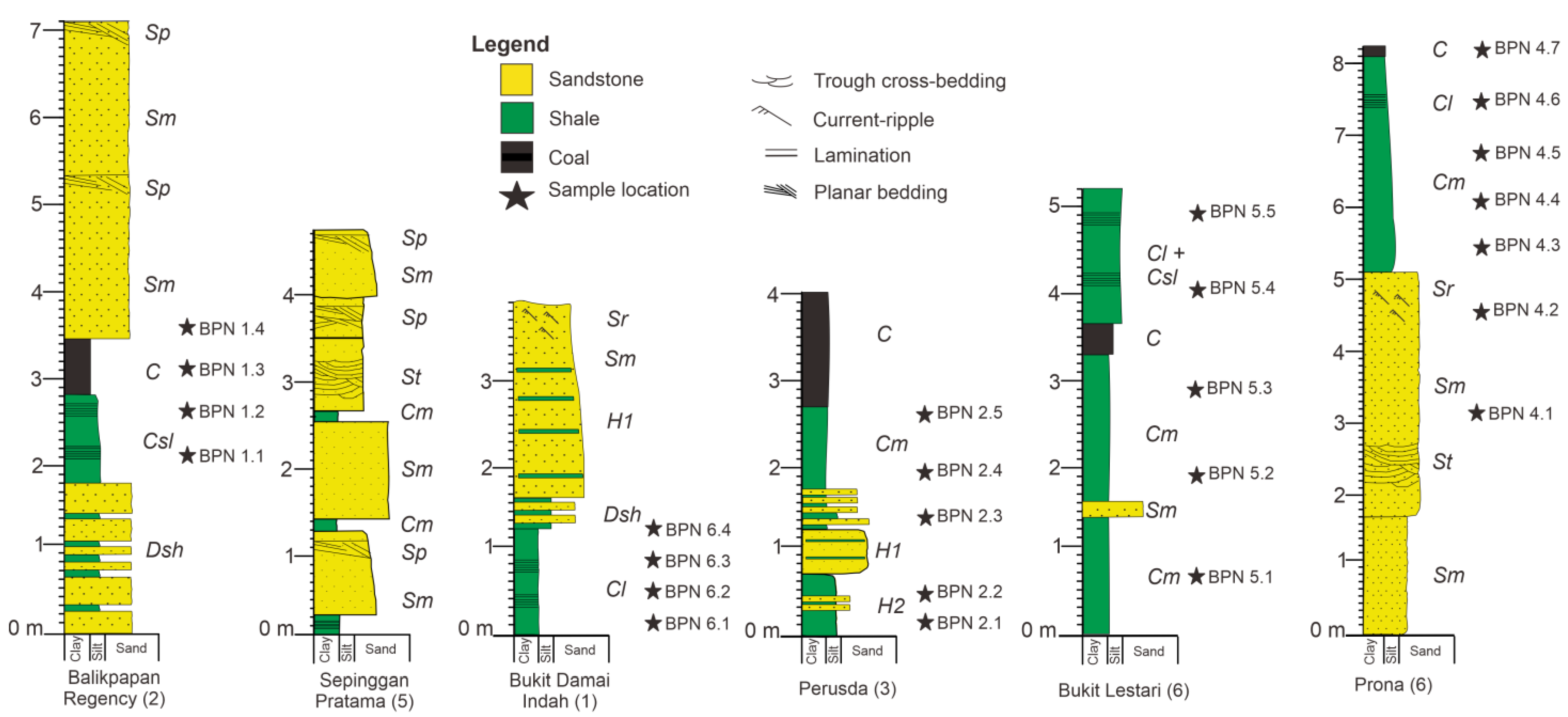
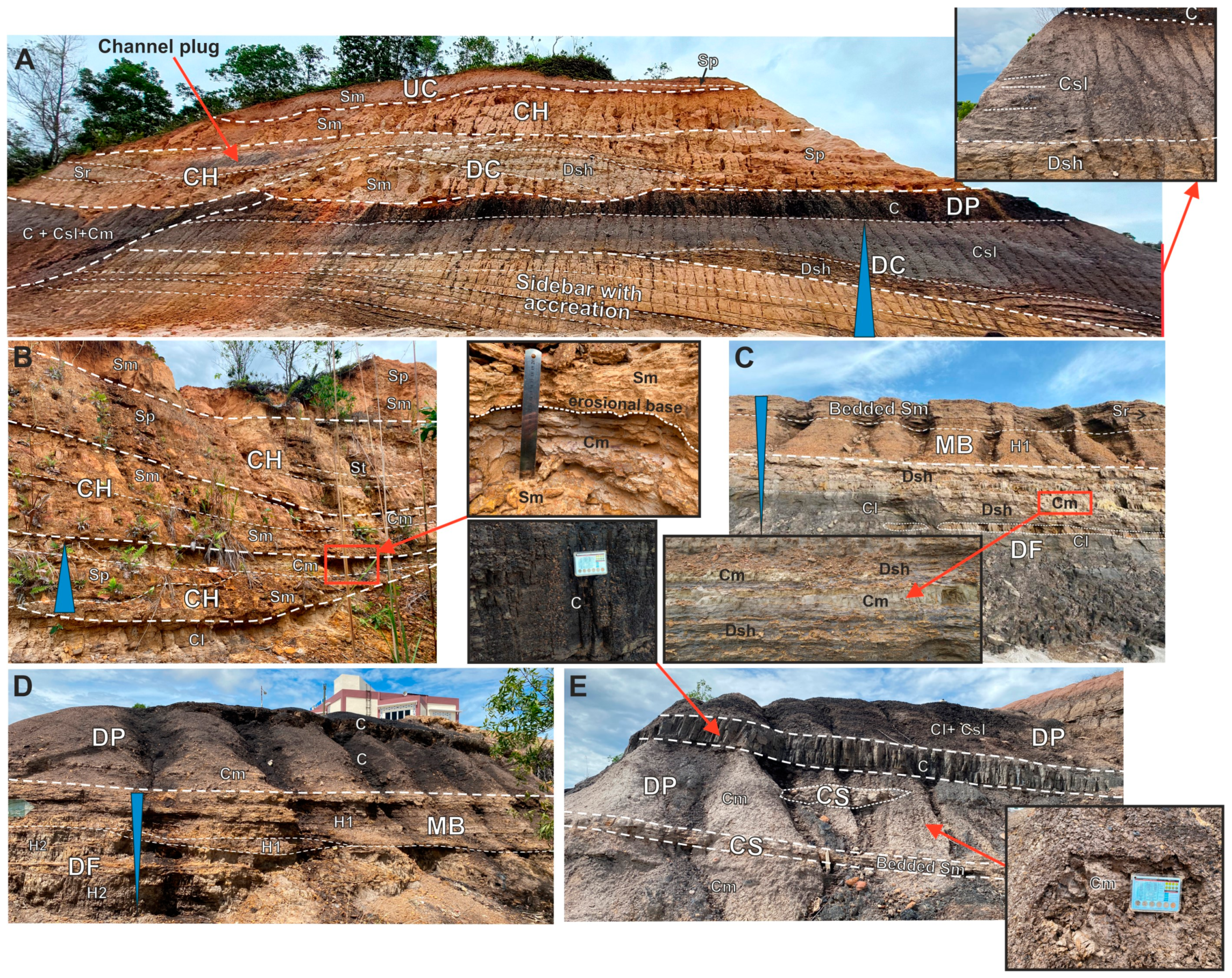
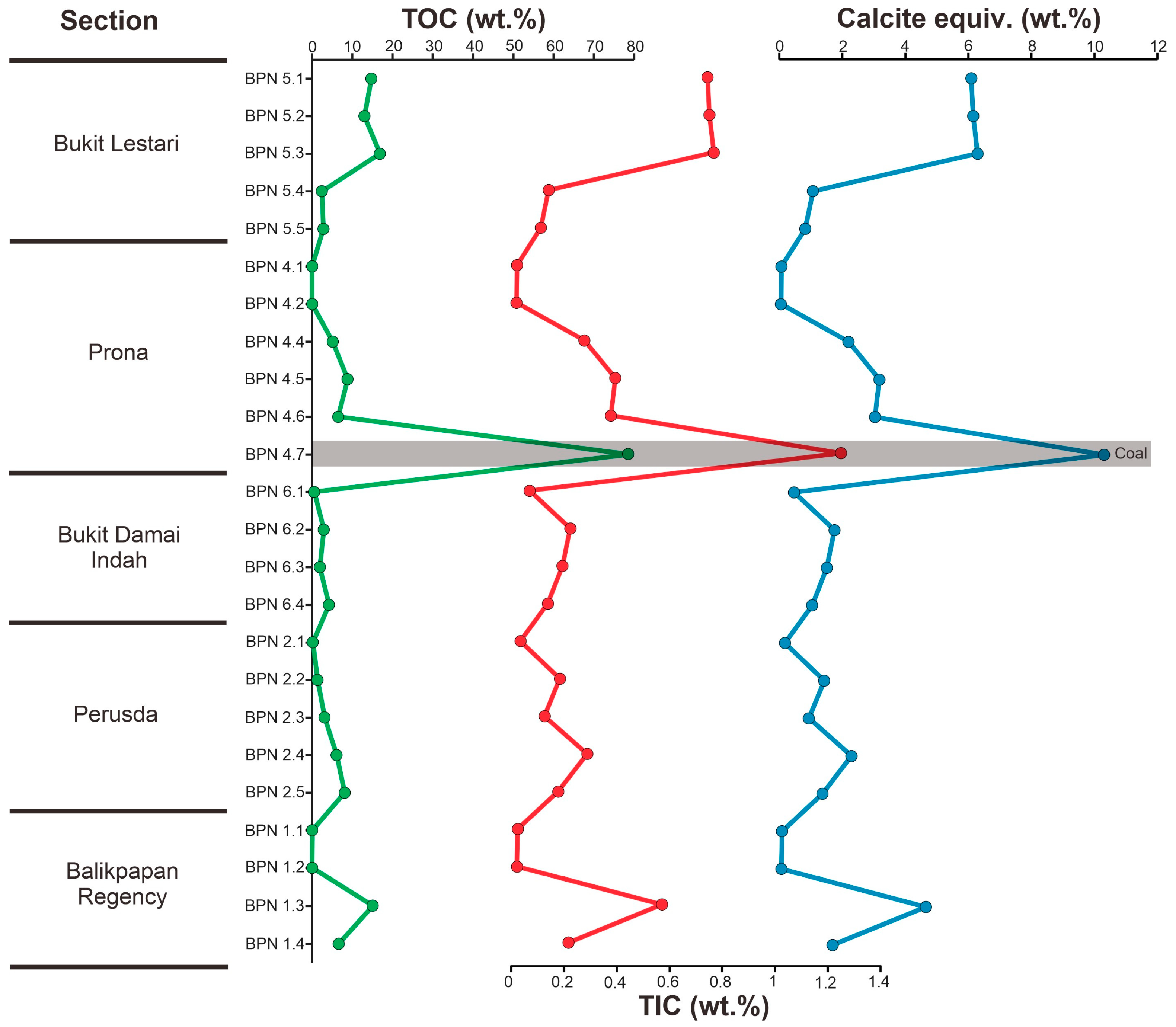
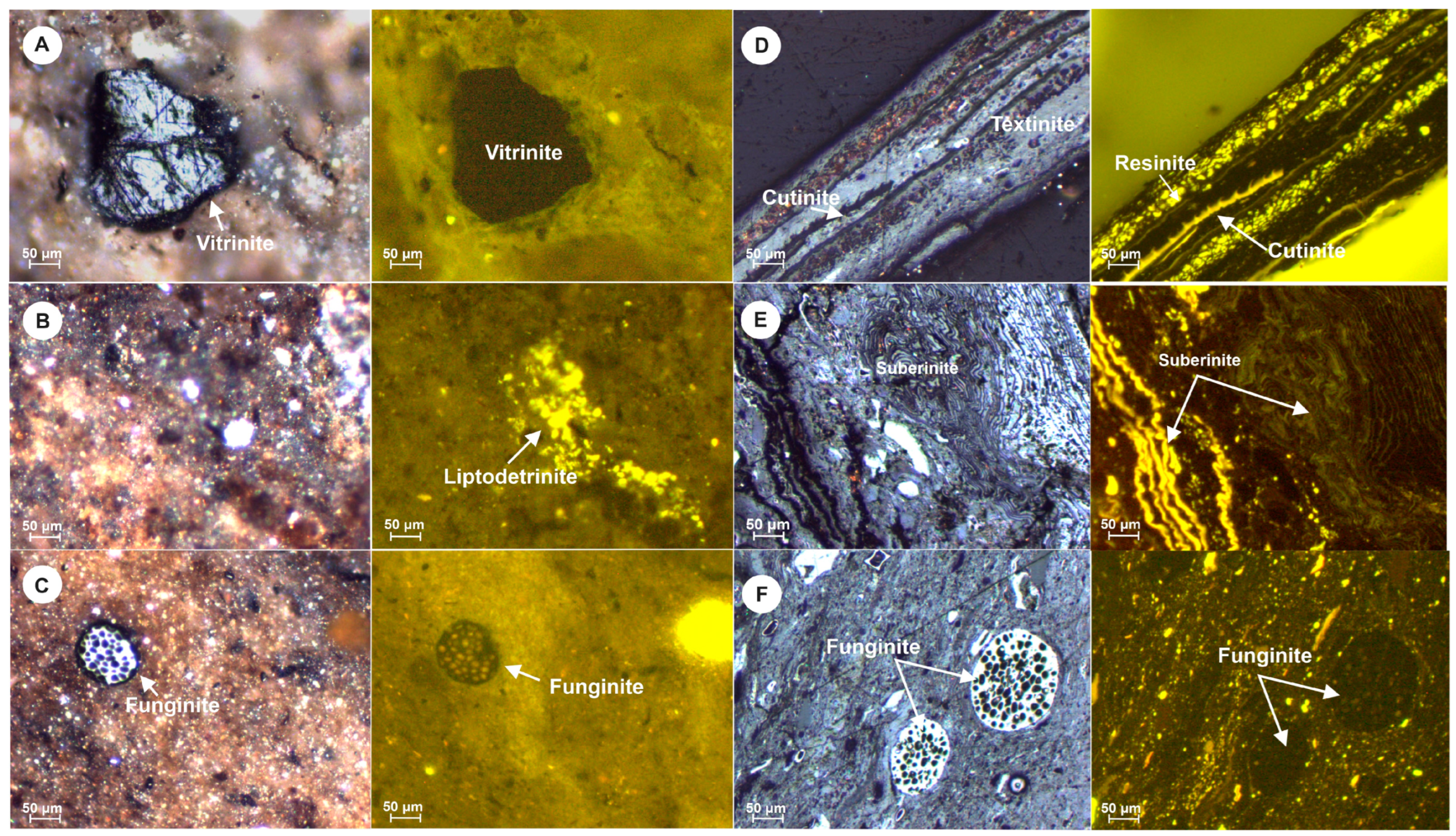
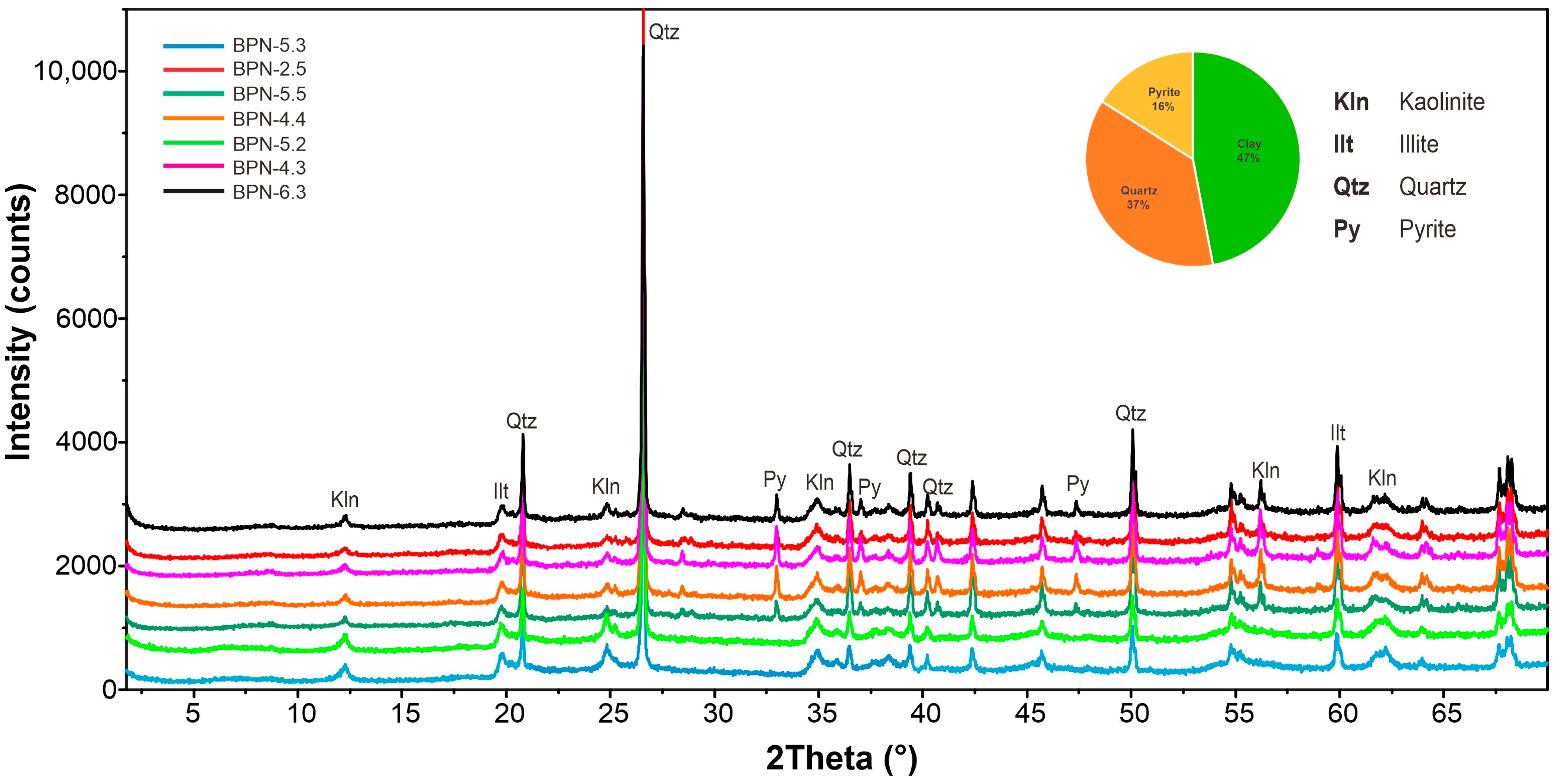
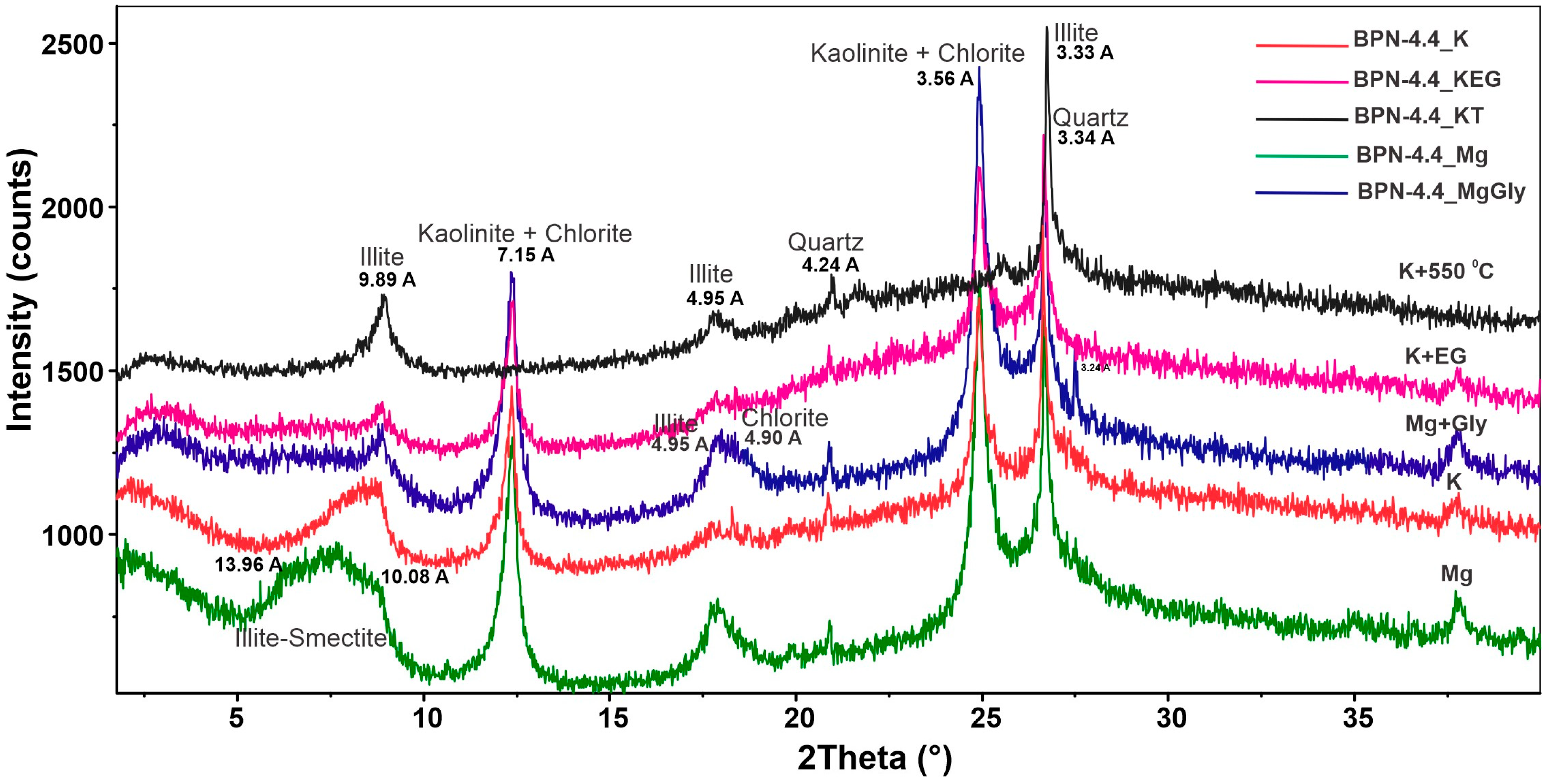
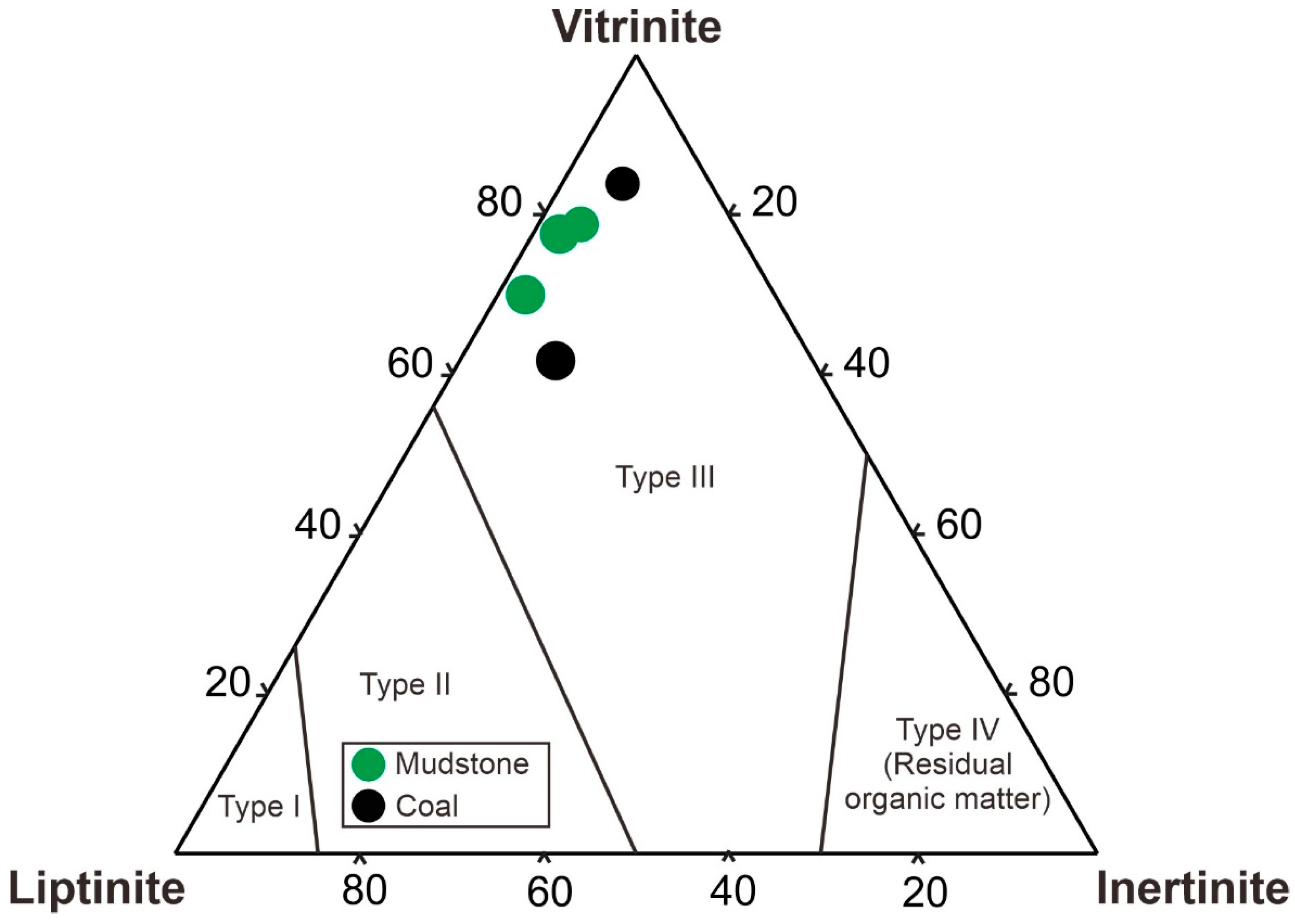

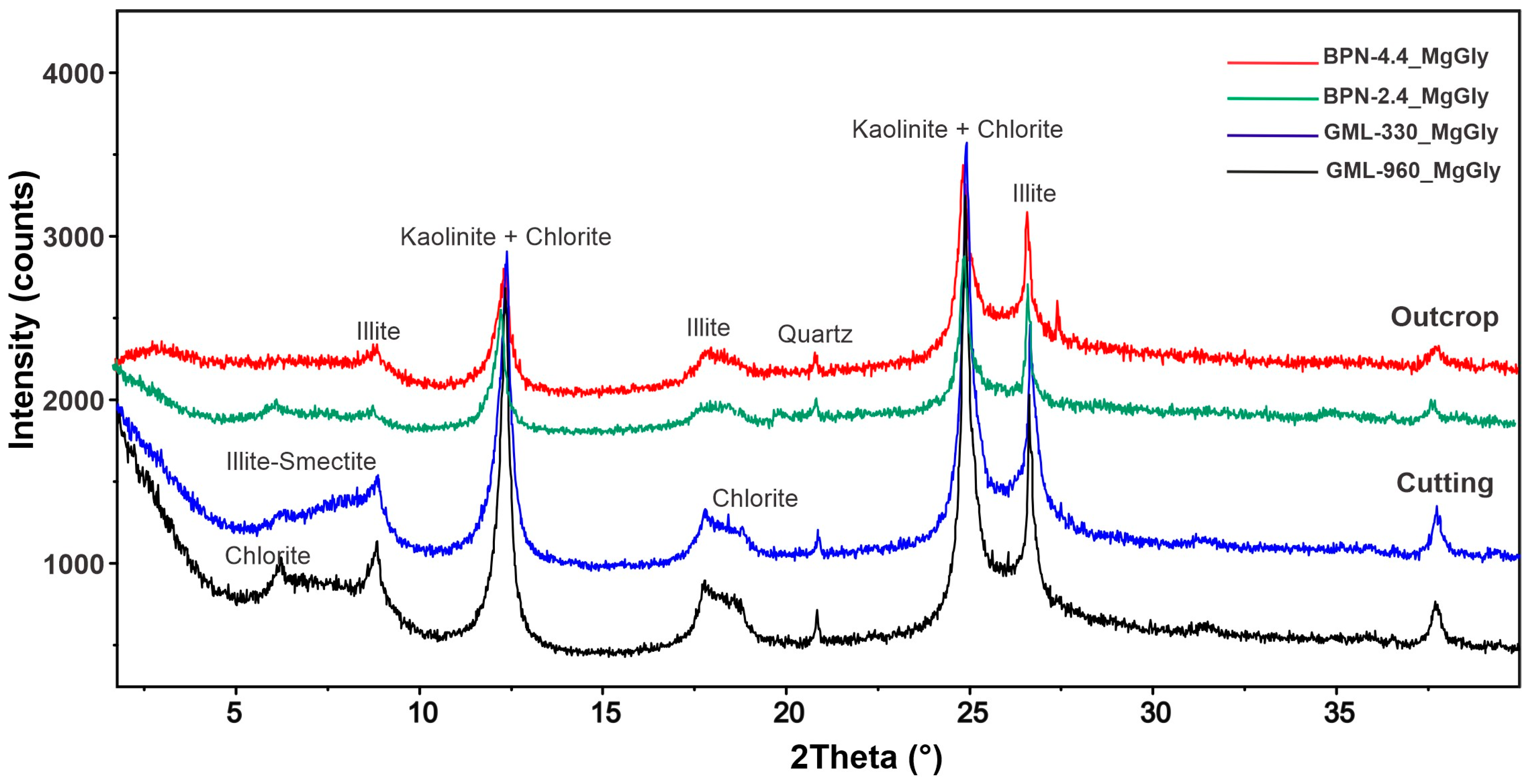
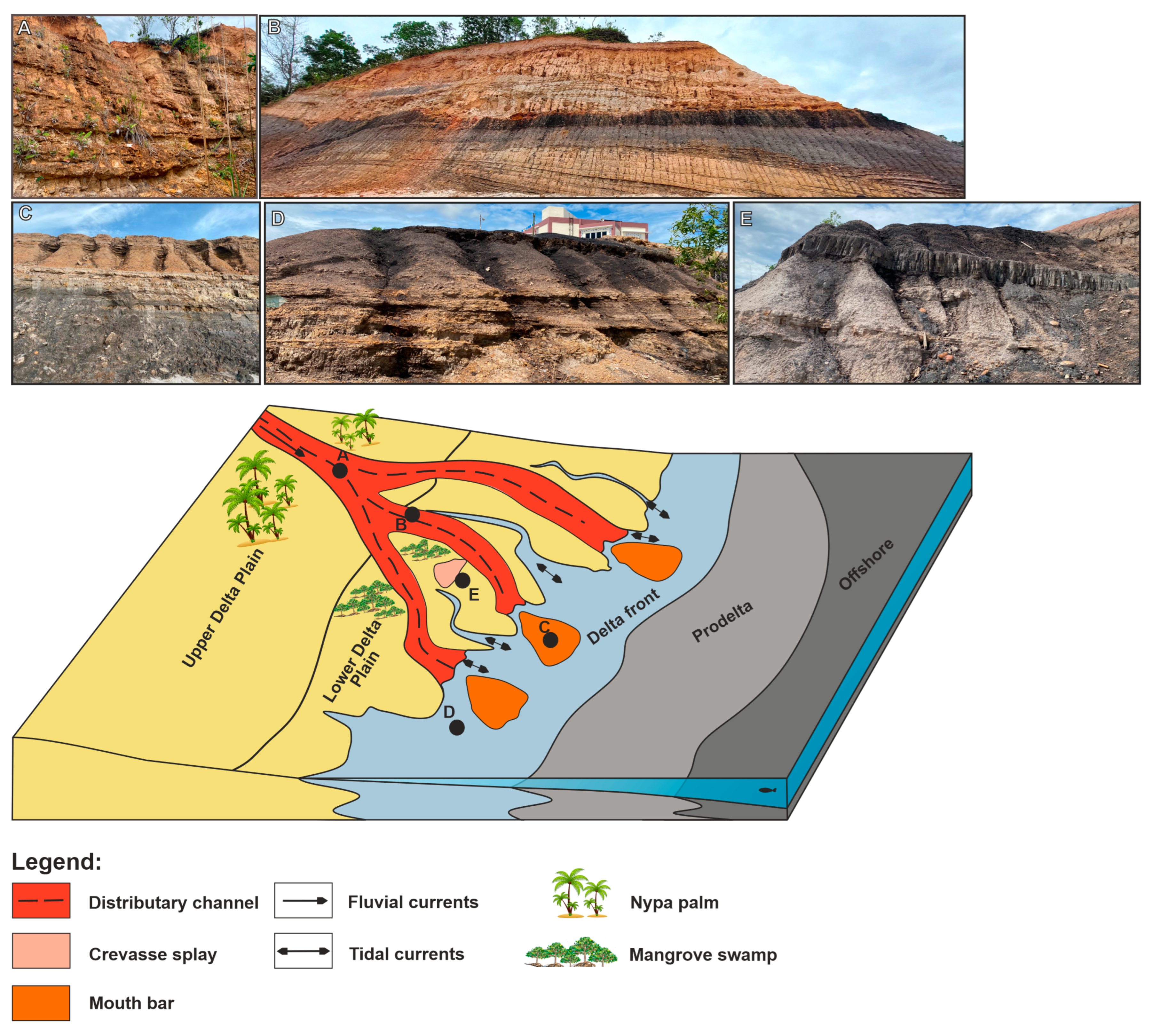
| Facies | Description | Interpretation | Figures | |
|---|---|---|---|---|
| Massive sandstone | Sm | Fine-to medium-grained sandstone, moderately to very well sorted, beige-to-yellow color, weathered, thickness ranging from 0.5 to 3 m, channel geometry, common coal fragments, bioturbation—vertical burrows and mottling. | Hyperconcentrated flow or a high-energy bedload deposition [24,25] | Figure 2A |
| Planar cross-bedded sandstone | Sp | Fine-to-medium-grained sandstone, typically white, yellow, orange, and grey colors, sometimes hard and compact, planar cross-bedding, fining upward, 1–4 m thick, rare bioturbation (simple burrows). | Two-dimensional subaqueous sandy dunes (lower flow regime) [25,26] | Figure 2B |
| Trough-bedded sandstone | St | Medium-grained sandstone, beige color, subrounded to rounded grains, moderately to well sorted, trough-cross bedding, ˂1.5 m thick, and a lateral extent of ±2 m. | Sinuous-crested bedforms that are formed under a lower flow regime [25,26] | Figure 2C |
| Rippled laminated sandstone | Sr | Fine-grained sandstone, ripple lamination, beige color, interbedded with massive claystone, soft sediment deformation, ±2 m thick, and a lateral extent of ±5 m. | Migration of current ripples in lower-flow-regime conditions [24,25,26] | Figure 2D |
| Horizontally laminated sandstone and siltstone | Dsh | Fine-to-medium-grained, laterally pervasive sandstone of beige-to-yellow color interbedded with light grey siltstone, heterolithic, horizontal to locally wavy fine lamination, with a lateral extent for tens of meters. | Suspension settling from standing water or weak currents [24,25,26] | Figure 2E |
| Sandstone-dominated heterolith | H1 | Heterolitic facies comprises interbedded beige-to-yellow sandstone, grey siltstone, and claystone; predominant sandstone is fine-grained, well-sorted, forming thin layers or lenses, and usually structureless (facies Sm). Current ripples are also preserved (Sr) with soft sediment deformation (load structure). | Fine-grained sediments are deposited from weak currents in a lower flow regime or from suspension [25,26]. Sandstone is deposited by a higher-energy current [27,28]. | Figure 2F |
| Mudstone-dominated heterolith | H2 | Heterolithic, laminated claystone and very fine-grained sandstone; sandstone forms thin discontinuous layers or lenses and wavy-to-lenticular bedding. Sandstone beds are a few mm to 2 cm thick; bidirectional current ripples possibly slightly wave-modified. | Deposits originated from currents and from suspension [25,26], bidirectional currents, and variation in mud and sand content are the result of the increasing and decreasing speed of current [27] | Figure 2G |
| Laminated silty claystone | Csl | Light-to-dark-grey color, silty claystone, horizontal to sub-horizontal lamination, a few meters thick, laterally extending for the first tens of meters. | Suspension settling from standing water or from weak currents [24,25,26] | Figure 2H |
| Massive claystone | Cm | Beige-to-grey massive claystone, forming thick beds or lenses, often interbedded with facies Cl and Csl, rare bioturbation (unbranched animal burrows), ±1 m thick. | Suspension settling [24,25,26] | Figure 2I |
| Laminated Claystone | Cl | Beige-to-dark-grey claystone, disintegrated, horizontal lamination, which can be interbedded with coal. ±1–2 m thick, with a lateral extent of ±5 m. | Suspension settling [28,29] | Figure 2I |
| Coal | C | Massive beds, lenses, or thin coal layers interbedded within siltstone, claystone, and occasionally sandstone, abundant coalified organic matter (plant fragments). It is ±2–4 m thick with a lateral extent of ±12 m. | Calm hydrodynamic conditions that allow the preservation of organic matter [25,29,30,31] | Figure 2J |
| Facie Association | Description | Interpretation | Figure | |
|---|---|---|---|---|
| Fluvial-dominated distributary channel | CH | Medium-to-coarse-grained sandstone comprises facies Sm, Sp, St, and Sr incised into facies Cm and Cl, fining upwards, 1–1.5 m thick, and laterally extending for 51 m, amalgamation of channels. | Sandstone bodies represent deposits (bars and dunes) of the distributary channel with fluvial dominance located typically on the upper delta plain. There is a predominant unidirectional current and bedload deposition. [24,25]. | Figure 4A,B |
| Sheet-like sandstone | UC | Medium-grained massive sandstone (facies Sm) and sandstone with faint cross-bedding (facies Sp); c. 0.5 m thick; sheet-like-to-tabular geometry; and a slightly undulating erosional base. | Sandstone bodies are interpreted as deposits of an unconfined fluvial flood event on the delta plain [25,32,33]. | Figure 4A |
| Tide-influenced distributary channel | DC | Fine-to-medium-grained sandstone consists of facies, Sm and Sp, and sandstone facies vertically pass into heterolithic facies Dsh (interbedded sandstone and siltstone) and laminated silty claystone (facies Csl), fining-upward trend, erosional base, incised in fine-grained sediments or coal, common mud-intraclasts and coal fragments at the base of the channel, bioturbation and mottling. | Large-scale bars and smaller-scale dunes were deposited in the distributary channel that typically occurs on the lower delta plain. Tidal processes influence water circulation up the distributary channel [27,34,35,36,37]. | Figure 4A |
| Crevasse splay | CS | Small lenticular or laterally prevalent sheet-like thinly bedded sandstone bodies (facies Sm) that are completely encased in fine-grained sediments of the delta plain, well-sorted and fine-grained sandstone, facies Sm, horizontally bedded, and beige color. | Crevasse splay | Figure 4E |
| Tide-influenced mouth bar | MB | Very fine-to-medium-grained sand; well sorted and well rounded; massive sandstone (Sm), parallel-bedded; sandstone-dominated heterolithic facies (H1), ripple cross-lamination (Sr); coarsening upward; thickening-upward, closely related to delta front facies association. ±3 m thick and a lateral extent of ±13 m. | Mouth bar, tidal influence: the distal mouth bar portion is shown in Figure 3d; the proximal part of the mouth bar is shown in Figure 3c [37,38,39]. | Figure 4C,D |
| Delta plain | DP | Laminated or massive claystone (facies Cl, Cm), silty claystone (Csl), interlayered with coal beds (C); and a lateral extent of ±15 m, max. 6 m thick. | Delta plain [27,38,40] | Figure 4A,D,E |
| Delta front | DF | Laminated grey claystone (Cl), massive beige claystone (Cm), heterolithic facies (H2 and Dsh), current ripples (Sr) coarsening-upward trend, ˂3 m thick, lateral extent of ±12 m, and overlain by mouth bar deposits. | Delta front, the coarsening-upward trend indicates progradation, tidal influence [10,27,40]. | Figure 4C,D |
| Samples ID | Lithology | Vitrinite (vol.%) | Liptinite (vol.%) | Inertinite (vol.%) |
|---|---|---|---|---|
| BPN 4.5 | Non-coal | 78.6 | 19.9 | 1.5 |
| BPN 2.5 | Non-coal | 71 | 27.4 | 1.6 |
| BPN 3.2 | Non-coal | 79.6 | 16.9 | 3.5 |
| BPN 1.3 | Coal | 60.7 | 27.5 | 11.8 |
| BPN 3.7 | Coal | 84.6 | 9.8 | 5.6 |
| Section | Samples | Clay Minerals % | Quartz % | Pyrite % |
|---|---|---|---|---|
| Perusda | BPN 2.3 | 33.4 | 60.5 | 6.1 |
| BPN 2.4 | 44.4 | 44.8 | 10.8 | |
| BPN 2.5 | 42.2 | 42.2 | 15.6 | |
| Bukit Damai Indah | BPN 6.3 | 45.0 | 38.6 | 16.4 |
| Prona | BPN 4.3 | 42.3 | 37.0 | 20.7 |
| BPN 4.4 | 38.9 | 36.7 | 24.4 | |
| BPN 4.5 | 45.3 | 38.4 | 16.3 | |
| BPN 4.6 | 42.6 | 41.4 | 16.0 | |
| Bukit Lestari | BPN 5.1 | 59.3 | 31.5 | 9.2 |
| BPN 5.2 | 59.2 | 28.7 | 12.1 | |
| BPN 5.3 | 63.0 | 24.7 | 12.3 | |
| BPN 5.4 | 43.8 | 23.8 | 32.4 | |
| BPN 5.5 | 50.8 | 29.6 | 19.6 |
Disclaimer/Publisher’s Note: The statements, opinions and data contained in all publications are solely those of the individual author(s) and contributor(s) and not of MDPI and/or the editor(s). MDPI and/or the editor(s) disclaim responsibility for any injury to people or property resulting from any ideas, methods, instructions or products referred to in the content. |
© 2024 by the authors. Licensee MDPI, Basel, Switzerland. This article is an open access article distributed under the terms and conditions of the Creative Commons Attribution (CC BY) license (https://creativecommons.org/licenses/by/4.0/).
Share and Cite
Jamaluddin; Schöpfer, K.; Wagreich, M.; Maria; Gier, S.; Fathy, D. Effect of Depositional Environment and Climate on Organic Matter Enrichment in Sediments of the Upper Miocene—Pliocene Kampungbaru Formation, Lower Kutai Basin, Indonesia. Geosciences 2024, 14, 164. https://doi.org/10.3390/geosciences14060164
Jamaluddin, Schöpfer K, Wagreich M, Maria, Gier S, Fathy D. Effect of Depositional Environment and Climate on Organic Matter Enrichment in Sediments of the Upper Miocene—Pliocene Kampungbaru Formation, Lower Kutai Basin, Indonesia. Geosciences. 2024; 14(6):164. https://doi.org/10.3390/geosciences14060164
Chicago/Turabian StyleJamaluddin, Kateřina Schöpfer, Michael Wagreich, Maria, Susanne Gier, and Douaa Fathy. 2024. "Effect of Depositional Environment and Climate on Organic Matter Enrichment in Sediments of the Upper Miocene—Pliocene Kampungbaru Formation, Lower Kutai Basin, Indonesia" Geosciences 14, no. 6: 164. https://doi.org/10.3390/geosciences14060164
APA StyleJamaluddin, Schöpfer, K., Wagreich, M., Maria, Gier, S., & Fathy, D. (2024). Effect of Depositional Environment and Climate on Organic Matter Enrichment in Sediments of the Upper Miocene—Pliocene Kampungbaru Formation, Lower Kutai Basin, Indonesia. Geosciences, 14(6), 164. https://doi.org/10.3390/geosciences14060164







